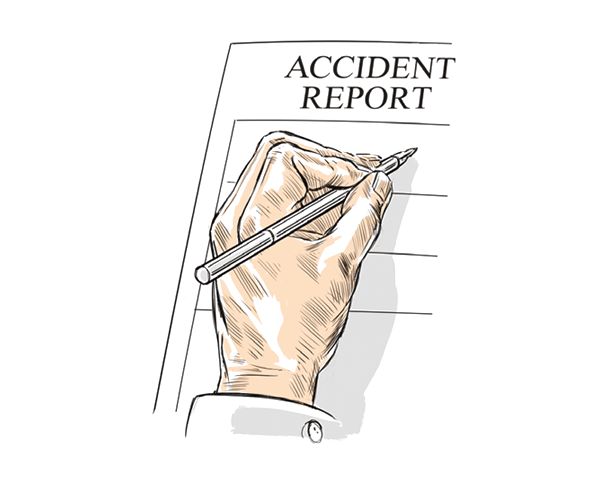Head down, gear up!
Piper PA-23-250 Aztec
C-GDUL
Trois-Rivières Airport, Quebec
Injuries: One serious, one minor
The aircraft, with two pilots on board – a low hours trainee pilot-in-command and a passenger flight instructor – was being operated in night VFR. On approach to Trois-Rivières Airport, a decision was made to conduct a touch-and-go rather than a missed approach. During the take-off after the touchdown, the propellers of both engines struck the surface of the runway. The aircraft got airborne and turned left, and the pilot lost control. The aircraft collided with the ground 222ft south of the runway and was destroyed by a post-impact fire. The two occupants evacuated the aircraft.
“During the touch and go, both propellers struck the runway”
The company providing the training often used an instructor as passenger, in a safety role. In this instance he intervened during the touch-and-go to resolve an incorrect flap and gear lever setting. While doing so, head down, he mistakenly thought the aircraft had got airborne and raised the undercarriage, the flaps subsequently moved to the up position. The pilot lost control of the aircraft as a result of the double prop strike following the undercarriage retraction and subsequent loss of lift once the flaps had retracted.
Comment The Piper Aztec has a quite involved interlocking arrangement between flaps and undercarriage, but the problems started after a relatively late change of intentions from a go-around to a touch-and-go. There were also no clearly defined cockpit procedures for the role of a ‘safety pilot’. This is one of a number of accidents when an intervention by the non-handling pilot has resulted in an accident.
Post-impact survival
Bell 206B3 Helicopter
VH-FHW
107km south-west of Jabiru, Northern Territory
Injuries: Three serious
As part of a cull of feral animals in Kakadu National Park, a crew of three were using a JetRanger helicopter for aerial platform shooting. While operating at about 50ft, the engine decelerated to idle, lost power, and subsequently the helicopter collided with terrain.
The spotter exited the helicopter and noted that the pilot and shooter were unconscious. He attempted to activate a handheld emergency position indicating radio beacon but having lost his corrective glasses, he was unable to read the instructions.
As the pilot regained consciousness, the pilot and spotter ensured the emergency locator transmitter (ELT) was on, and the spotter tried to make the pilot and shooter comfortable.
The rifle was still in the helicopter and the barrel had punctured the floor of the cabin. The spotter made the weapon safe by removing the magazine and selecting the safety.
The joint rescue coordination centre detected the signal from the ELT and tasked a passing RAAF Hercules to search for the source. The crew subsequently found the wreckage and directed a nearby helicopter to the scene as well as the emergency medical service (EMS) helicopter which arrived some five minutes later. Following news of the event, the fuel supply at Jabiru was closed for testing as a precaution. This prevented the EMS helicopter from refuelling at Jabiru and delayed a recovery which ultimately took almost nine hours.
Comment As with everything in Australia, distances are huge so translating this accident into a European context is not always meaningful but the report does make some useful survival observations, particularly over the legibility of safety instructions (day or night) and the need to carry a retrievable spare pair of specs. Also, concern that fuel contamination may have been a factor further complicated recovery, something to be considered in any engine failure situation.
Fatal beat-up
Harmon Rocket II
C-FZXS
Hugget/Goodwood Field Aerodrome, Alberta,
Injuries: Two fatal
The Harmon Rocket II amateur-built aircraft departed for a flight to Hugget/Goodwood Field Aerodrome, with two people on board. The purpose of the flight was to join a gathering of friends who were to spend the afternoon go-karting at the racetrack adjacent to the airfield. After flying a second circuit, the aircraft descended to approximately 25ft AGL and flew over the racetrack straight from north to south. At the south end of the straight, the aircraft initiated a climb and struck the upper wires of an unmarked power line at 35ft agl. The aircraft pitched up steeply, and climbed to 700ft before rolling and descending wings-level until it struck the ground violently.
Comment The ‘straight’ to the racetrack and the airfield runway make an angle of approximately 60° and are very close to each other. There can have been no mistaking one for the other but the illusion may well have been to create an impression the straight was a runway with all the protections that would normally confer. Clearly it wasn’t, and it didn’t, with fatal consequences. Normal flight below 500ft is prohibited in most parts of the world for good reason and is particularly dangerous when it is impromptu.
Troubling hush
Velocity XL-5
N735D
St Cloud, Florida
Injuries: Two serious
Shortly after take-off, when the aeroplane was at an altitude of 2,000ft, the engine and electrical system failed simultaneously. The pilot was unable to restart the engine and made a forced landing to an open field, during which the aeroplane flipped over and sustained substantial damage. The aeroplane wreckage was not located until over four hours after the accident.
The aeroplane’s engine was equipped with a dual electronic ignition system that required electrical power to operate. The pilot-builder had wired the electrical system through a 24v battery, including the dual electronic ignition system. Post-accident examination revealed that the lugs that connected the positive and negative leads of the aeroplane’s electrical system to the 24v battery were not crimped properly and that the leads had separated from their lugs, which resulted in the complete loss of electrical and engine power.
The aeroplane’s 406-MHz emergency locator transmitter (ELT) triggered on impact, and a beacon alert was sent and was received by the Air Force Rescue Coordination Centre (AFRCC). The AFRCC called the pilot’s mobile phone twice shortly after the accident, but the phone had been displaced during the accident sequence, and the pilot was unable to retrieve it to answer.
The pilot’s daughter did not receive a call from the AFRCC even though she was listed as an emergency contact. A review revealed that the on-duty controller attempted to locate the beacon and initially determined that the aeroplane was most likely airborne with an active ELT and closed the incident.
Comment Homebuilding can be great fun and massively rewarding, but there are some areas where poor skills can have serious consequences and the main electrical system is certainly one of them. Planning that system takes diligence too and so having a dual electronic ignition system without back-up power generation means everything will go very quiet, very quickly, should the main power leads disconnect.
Water bottle dangers!
Robin DR400-140B
F-GYKC
Saint-Girons Antichan, France
Injuries: None
While carrying out pre-take-off checks at Saint-Girons Aerodrome for a flight to Toulouse with his 10-year-old son, the pilot was interrupted by a landing aircraft and had to reposition his aircraft to let the landing aircraft past.
“In the wreckage was a deformed water flask wedged in the controls”
Once pre-take-off actions had been completed, the pilot commenced his take-off run, but shortly after getting airborne the aircraft began to veer to the right. The pilot tried to counter the movement, but the control column seemed blocked. He decided to abort the take-off, reduced power and attempted to land on the edge of the runway. The pilot recalled hearing the stall warning, the left wing suddenly dropped and a violent collision with the ground ensued.
The pilot recalled doing the full and free control checks during his pre-take-off actions but added that his son then drank from a water flask just before commencing the take-off. Although he asked him to put it on the back seat, his son left it on his own seat.
Examination of the wreckage found a deformed water flask wedged in the controls and a number of objects from an unsecured container on the rear seat, which had been thrown forward by the impact. During the take-off roll, the flask fell on the floor and after rotation, when the pilot needed to correct a slight roll, the controls had become blocked.
Comment So, an innocuous water bottle brought down an aircraft? It would appear so! Carrying anything into a cockpit which is not properly secured creates a risk as this accident demonstrates. And that includes the bucket of aircraft tie-downs which was sitting on the rear seat!







